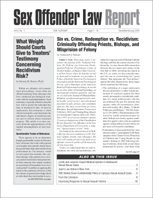Residency Restrictions: What We Know
Author: Tasha J. Youstin.
Source: Volume 10, Number 02, February/March 2009 , pp.19-23(5)

< previous article |next article > |return to table of contents
Abstract:
Residency restrictions are one of the newest requirements to be enacted in a wave of legislative policies targeting sexual offenders over the last decade. These restrictions prohibit registered sexual offenders from living within a specific number of feet from areas such as schools, parks, day care facilities, bus stops, and other areas where children congregate. As of 2008, over 30 states have enacted such policies against sex offenders, with restrictions ranging from 500 to 2,500 feet. (See M.L. Meloy, S.L. Miller, and K.M. Curtis, “Making Sense Out of Nonsense: The Deconstruction of State-Level Sex Offender Residence Restrictions,” 33 (2) Amer. J. of Crim. Just. 209-222 (2008), reviewed below.) Residency restrictions can be enacted at the state or local levels, and although some restrictions only target registered sex offenders with minor victims, others target anyone required to register as a sexual offender.Keywords:
Affiliations:
1: John Jay College of Criminal Justice.